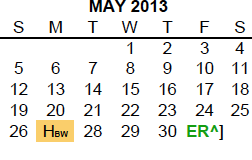As the second semester wraps up, students and teachers are beginning to plan for the last few weeks of school, but many are confused by the calendar. Although this grading period is called the sixth six weeks, it is actually seven weeks long. The seventh and last week of the 2013-2014 school year is set apart for finals.
“Spring always has more days in it than the fall, because we have to start so late, so we get more days in the spring,” principal Gavan Goodrich said. “But the way we work the schedule out, that last week is for finals. So you get six full weeks of instruction and that last week is for finals.”
The extra week in this quarter is also a result of ending the first semester before winter break.
“We ended our first semester earlier than normal, because we ended it before Christmas, before the holidays,” registrar Debbie Barnes said. “Before, we had ended it about two weeks after that. I’m guessing that’s why there are seven weeks instead of six. There were a couple times this school year when we actually had more time.”
Each grading period in the second semester has had more than the allotted thirty days, while the quarters in the first semester were shorter than usual. Although the phrase, “six weeks” has been very loose this year, it goes unnoticed by most students and some of the more organized teachers.
“It doesn’t usually affect me,” social studies teacher Erin McClanahan said. “Once or twice a year it’ll kind of mess up my thinking, but usually I just have to look at it and plan from a six weeks standpoint instead of five, seven, or however it ends up each grading period.”















